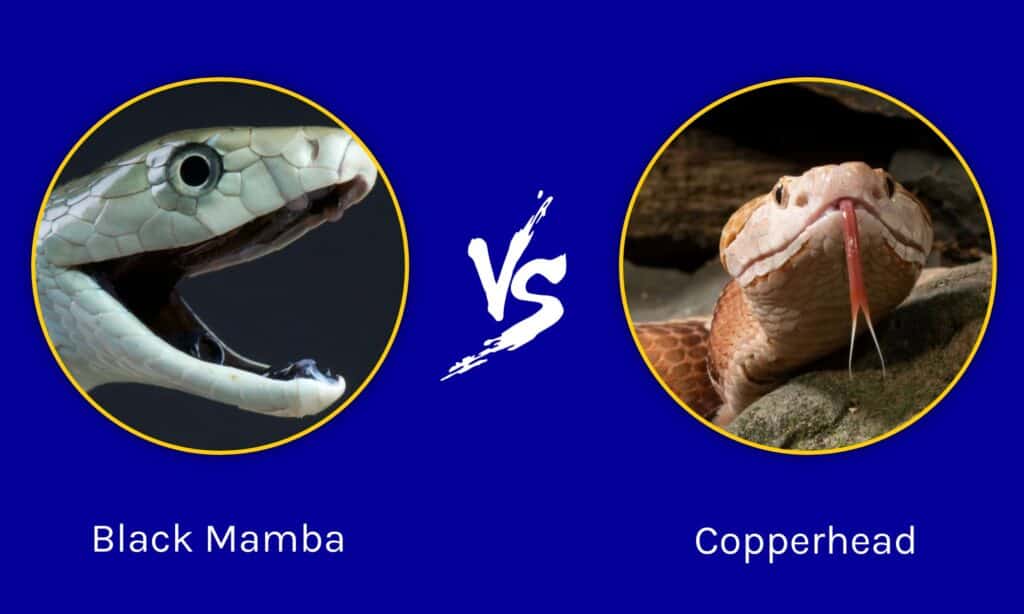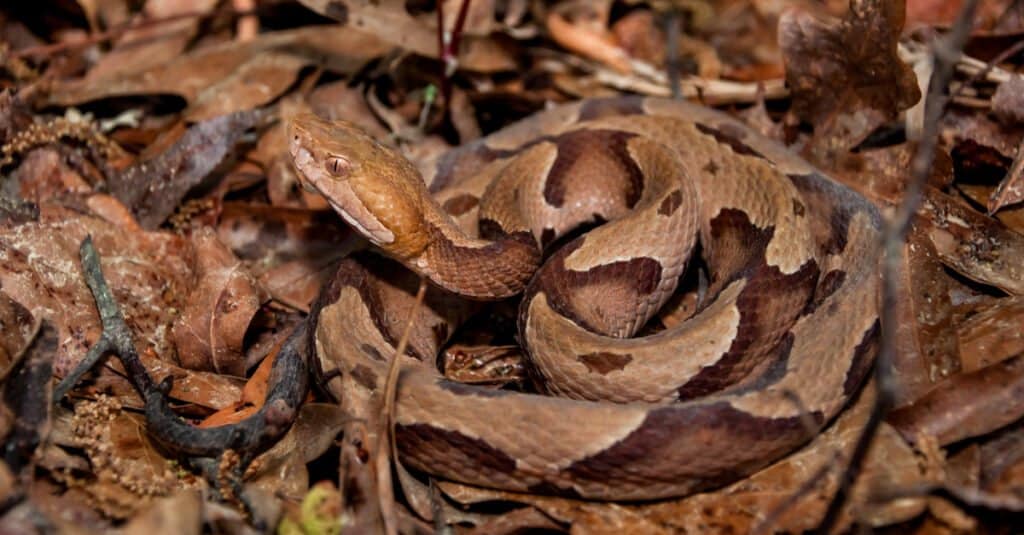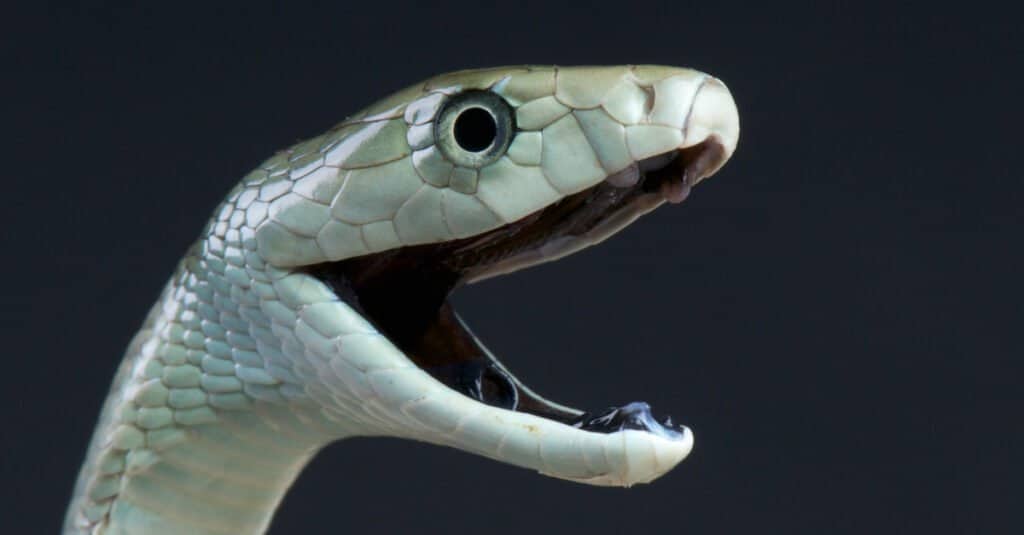The copperhead is a common venomous snake in the eastern United States. Although the snake is maligned for having a venomous bite, it’s recognized as the least dangerous of the venomous snakes in the country. If the impact of snake venom was a scale, the copperhead would be at one end and the black mamba would be at the other. This snake’s powerful venom and other factors make it the world’s most dangerous snake. So, in a black mamba vs copperhead fight, who would win? That’s the question we’re going to answer by carefully considering each of the snakes.
Comparing a Black Mamba and a Copperhead

| Black Mamba | Copperhead | |
|---|---|---|
| Size | Weight: 3.5-4.5lbs Length: 6ft-9.5ft, up to 14ft maximum | Weight: 0.25lbs-0.75lbs Length: 2ft-3.3ft |
| Speed and Movement Type | – 7-20 mph – 12 mph is probably a more accurate maximum speed | – 1-3 mph – Fast bite speed |
| Venom | – Powerful venom that can kill humans quickly – 100g-120g of venom per bite on average with 400g maximum – Capable of killing 10-20 humans with a single bite – 100% envenomation rate and delivers several bites | – Hemotoxic venom – Results in 0.01% fatality rate in humans with treatment – Most of the bite damage is localized, but it requires treatment – Issues dry bites and is considered the least dangerous of all U.S. venomous snakes. |
| Defenses | – A highly aggressive snake that doesn’t back down from a fight – Speed | – Camouflages itself in wooded areas and fallen leaves – Skittish demeanor, but will stay and attack if provoked |
| Offensive Capabilities | – Capable of raising 40% of its body off the ground to land strikes from far away – Bites several times – Can use its length and weight to wrestle other snakes | – Fast biting strike |
| Predatory Behavior | Ambush predator | Ambush predator |
What Are Key Differences Between a Black Mamba and a Copperhead?

The Copperhead’s scales are keeled, and their eyes have vertical pupils that make them resemble a cat’s eyes.
©Creeping Things/Shutterstock.com
The main differences between a black mamba and copperhead are their size, venom, and speed. Black mambas are long snakes that can grow up to 14ft in length, use powerful neurotoxic venom to kill foes, and can move up to 12 mph, but a copperhead will only grow about 3ft long, uses a relatively weak hemotoxic venom, and moves rather slowly at 3 mph.
The differences between these snakes are very pronounced. We’ll use the insights gained from identifying these differences along with other factors to determine the snake with the best chance at winning this fight.
What Are the Key Factors in a Fight Between a Black Mamba and a Copperhead?

Copperheads are small snakes that easily blend in with foliage and detritus.
©Jay Ondreicka/Shutterstock.com
The major factors in a fight between a black mamba and a copperhead are similar to other fights in the animal kingdom. We must look at the size, speed, and fighting abilities along with other “X-factors” that set them apart. By recognizing the advantages these snakes have over one another, we’ll have a better idea of which one is set to win this battle.
Black Mamba vs Copperhead: Size
The black mamba is larger than a copperhead snake. Black mambas grow between 6.5ft and 9.5ft, weighing up to 4.5lbs. However, even larger black mambas have been spotted, up to 14ft in length. The copperhead can weigh as little as 0.75lbs and only grows up to 3ft long.
Black mambas have a clear size advantage over copperheads.
Black Mamba vs Copperhead: Speed and Movement
A black mamba is faster than a copperhead. The black mamba is one of the fastest snakes in the world in terms of locomotion and striking. They can move at speeds of 12 mph or up to 20 mph, depending on the accuracy of sources. Yet, the copperhead is estimated to move between 1 mph and 3 mph, far slower than the black mamba.
The black mamba has a speed advantage over the copperhead snake.
Black Mamba vs Copperhead: Venom
The black mamba has some of the deadliest venom on Earth. The venom is a potent neurotoxin that has a 100% mortality rate in humans without treatment. Also, every time the black mamba bites, it uses venom.
The copperhead issues a lot of dry bites, bites without venom, and its venom is not that deadly. When they bite humans, the individual will require medical treatment. However, the mortality rate is 0.01% with treatment. That does not mean humans should underestimate these snakes, only that their venom pales in comparison to the black mamba’s venom.
Black Mamba vs Copperhead: Physical Defenses
Copperheads have good camouflage in the wooded areas they frequent. They are especially hard to find in fallen leaves during autumn. Aside from their camouflage and the ability to hide in small places, they don’t have much in the way of defense.
Black mambas may initially attempt to flee using their great speed, but they will quickly turn aggressive when the need arises. Their aggressiveness and speed are their defensive capabilities.
Copperheads have the defensive advantage because they avoid more fights and keep safe.
Black Mamba vs Copperhead: Combat Skills
Copperheads are known for having a fast bite, but they don’t have the length to suddenly bite a creature that is very far away. Not only do black mambas have an incredibly fast bite, but they can close the distance on their prey in a flash.
When the time comes to fight, a black mamba will rear back and lift over a third of its body off the ground and then strike. This ability allows the mamba to lash out at foes from several feet away while moving quicker than their enemies can react.
All in all, the mamba has better combat skills, greater reach, and deadlier venom than the copperhead.
Who Would Win in a Fight Between a Black Mamba and a Copperhead?

Black mambas are blazing fast and highly venomous.
©reptiles4all/Shutterstock.com
A black mamba would win a fight against a copperhead. Black mambas have just about every important advantage over the diminutive copperhead. They’re larger, faster, have deadlier venom, and can attack from farther away.
The fight would probably begin and end with the black mamba swiftly moving in and attacking the copperhead from several feet above the ground. That would essentially neutralize the counterattack of the copperhead, leaving it to succumb to the black mamba’s venom.
Even if both snakes bit each other at the same time, the black mamba would be the last snake standing. Its venom is far too potent for the copperhead’s small body to handle.
Other Animals That Could Take Down a Black Mamba
The black mamba is a powerful venomous snake that could win a fight against a copperhead snake. However, what about a rattlesnake? If faced head to head, the rattlesnake would pull a victory. This is due to its longer length, and stronger venom. The decisive factor in this confrontation would be whoever had the chance to strike first and make it fatal.
Although the rattlesnake could potentially inject venom it may not be able to strike first. In this case, the black mamba is a swift and slender target that could attack from a further distance, this would make it more likely to land a bite on the rattlesnake.
Additionally, the strength of the snake’s venom would be vital in this scene because the rattlesnake’s hemotoxic venom could be lethal to other snakes, it is less rapid-acting and deadly than a neurotoxin.
The photo featured at the top of this post is © 131346563/Shutterstock.com
Discover the "Monster" Snake 5X Bigger than an Anaconda
Every day A-Z Animals sends out some of the most incredible facts in the world from our free newsletter. Want to discover the 10 most beautiful snakes in the world, a "snake island" where you're never more than 3 feet from danger, or a "monster" snake 5X larger than an anaconda? Then sign up right now and you'll start receiving our daily newsletter absolutely free.
Thank you for reading! Have some feedback for us? Contact the AZ Animals editorial team.






